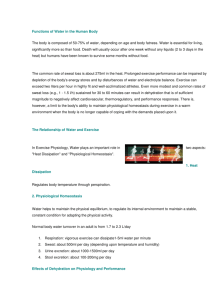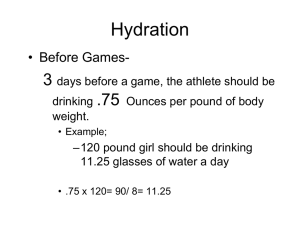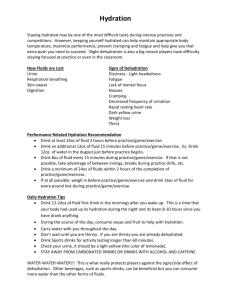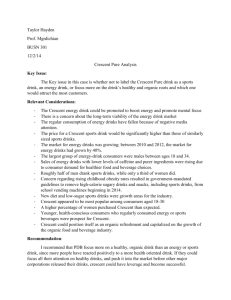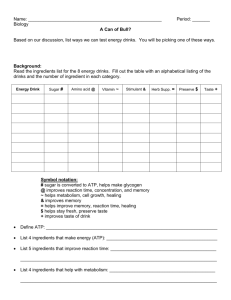Sports Drinks BrianMac
advertisement
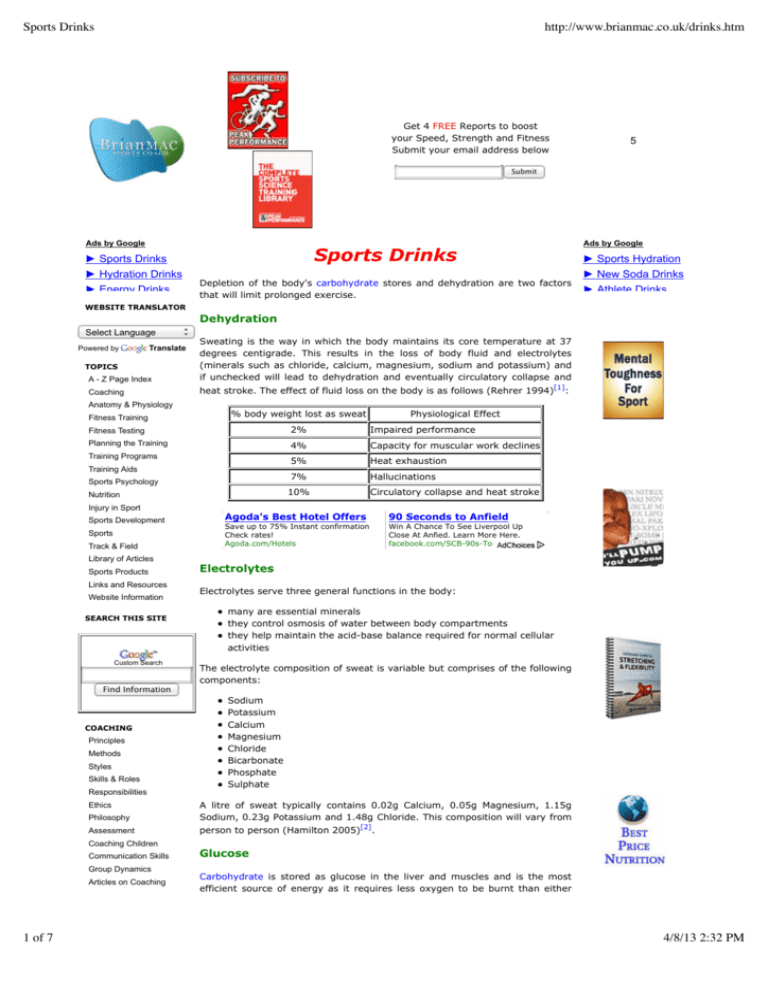
Sports Drinks http://www.brianmac.co.uk/drinks.htm Get 4 FREE Reports to boost your Speed, Strength and Fitness Submit your email address below 5 Submit Ads by Google ► Sports Drinks ► Hydration Drinks ► Energy Drinks Sports Drinks Ads by Google ► Sports Hydration ► New Soda Drinks Depletion of the body's carbohydrate stores and dehydration are two factors ► Athlete Drinks that will limit prolonged exercise. WEBSITE TRANSLATOR Dehydration Select Language Powered by Translate TOPICS A - Z Page Index Coaching Anatomy & Physiology Sweating is the way in which the body maintains its core temperature at 37 degrees centigrade. This results in the loss of body fluid and electrolytes (minerals such as chloride, calcium, magnesium, sodium and potassium) and if unchecked will lead to dehydration and eventually circulatory collapse and heat stroke. The effect of fluid loss on the body is as follows (Rehrer 1994)[1]: Fitness Training % body weight lost as sweat Fitness Testing 2% Impaired performance Planning the Training 4% Capacity for muscular work declines Training Programs 5% Heat exhaustion 7% Hallucinations Training Aids Sports Psychology 10% Nutrition Injury in Sport Sports Development Sports Track & Field Library of Articles Sports Products Links and Resources Website Information SEARCH THIS SITE Custom Search Find Information COACHING Principles Methods Styles Skills & Roles Responsibilities Circulatory collapse and heat stroke Agoda's Best Hotel Offers 90 Seconds to Anfield Save up to 75% Instant confirmation Check rates! Agoda.com/Hotels Win A Chance To See Liverpool Up Close At Anfied. Learn More Here. facebook.com/SCB-90s-To-Anfield Electrolytes Electrolytes serve three general functions in the body: many are essential minerals they control osmosis of water between body compartments they help maintain the acid-base balance required for normal cellular activities The electrolyte composition of sweat is variable but comprises of the following components: Sodium Potassium Calcium Magnesium Chloride Bicarbonate Phosphate Sulphate Philosophy A litre of sweat typically contains 0.02g Calcium, 0.05g Magnesium, 1.15g Sodium, 0.23g Potassium and 1.48g Chloride. This composition will vary from Assessment person to person (Hamilton 2005)[2]. Ethics Coaching Children Communication Skills Group Dynamics Articles on Coaching 1 of 7 Physiological Effect Glucose Carbohydrate is stored as glucose in the liver and muscles and is the most efficient source of energy as it requires less oxygen to be burnt than either 4/8/13 2:32 PM Sports Drinks A - Z Page Index ANATOMY PHYSIOLOGY Physiology - Systems Body Build Biomechanics Energy Pathways Maximum Heart Rate Movement Analysis Articles on Physiology A - Z Page Index FITNESS TRAINING Training Principles Skill Classification Skill Development Conditioning Core Stability Endurance http://www.brianmac.co.uk/drinks.htm Protein or fat. The normal body stores of carbohydrate in a typical athlete are: 70kg male athlete - Liver glycogen 90g and muscle glycogen 400g 60kg female athlete - Liver glycogen 70g and muscle glycogen 300g. During hard exercise, carbohydrate can be depleted at a rate of 3-4 grams per minute. If this is sustained for 2 hours or more, a very large fraction of the total body carbohydrate stores will be exhausted and if not checked will result in reduced performance. Recovery of the muscle and liver glycogen stores after exercise will normally require 24-48 hours for complete recovery. During exercise, there is in an increased uptake of blood glucose by the muscles and to prevent blood glucose levels falling the liver produces glucose from the liver stores and lactate. Consuming carbohydrate before, during and after exercise will help prevent blood glucose levels falling too low and help maintain the body's glycogen stores. Many athletes cannot consume food before or during exercise and therefore a formulated drink that will provide carbohydrate is required. Flexibility & Mobility Speed Hydration Strength VO2 max Fluid absorption Articles on Training A - Z Page Index Two main factors affect the speed at which fluid from a drink gets into the body: FITNESS TESTING Performance Tests Ideal Weight Blood Pressure Articles on Evaluation A - Z Page Index PLANNING Performance Profiling LTAD Creating a Training Plan Warm Up & Cool Down Tapering the Training Articles on Planning A - Z Page Index TRAINING PROGRAMS Training Programs Personal Exercise Plan CNS Training Heart Rate Training Aqua Training Fartlek Training Medicine Ball Training Circuit Training Hill Training Plyometric Training Weight Training Complex Training A - Z Page Index TRAINING AIDS the speed at which it is emptied from the stomach the rate at which it is absorbed through the walls of the small intestine The higher the carbohydrate levels in a drink the slower the rate of stomach emptying. Isotonic drinks with a carbohydrate level of between 6 and 8% are emptied from the stomach at a rate similar to water. Electrolytes, especially sodium and potassium, in a drink will reduce urine output, enable the fluid to empty quickly from the stomach, promote absorption from the intestine and encourage fluid retention (Unknown 1993)[3]. What's wrong with water? water causes bloating which will suppress thirst and therefore drinking water contains no carbohydrate or electrolytes Calculating personal fluid needs During an endurance event, you should drink just enough to be sure you lose no more than 2% of pre-race weight. This can be achieved in the following way: Record your naked body weight immediately before and after a number of training sessions, along with details of distance/duration, clothing and weather conditions Add the amount of fluid taken during the session to the amount of weight lost - 1 kilogram (kg) is roughly equivalent to 1 litre of fluid (1lb approx. 0.5 litre) After a few weeks you should begin to see some patterns emerging and can calculate your sweat rate per hour Once you know what your sweat losses are likely to be in any given set of environmental conditions, you can plan your drinking strategy for any particular event Ergogenic Aids Supplements Sports Drinks Sports Massage Articles on Training Aids A - Z Page Index SPORTS PSYCHOLOGY Psychology 2 of 7 Sports Drinks There are three types of sports drink all of which contain various levels of fluid, electrolytes and carbohydrate. 4/8/13 2:32 PM Sports Drinks http://www.brianmac.co.uk/drinks.htm Competitive Anxiety Stress Management Relaxation Techniques Type Isotonic Content Fluid, electrolytes and 6 to 8% carbohydrate Mental Imagery Hypotonic Fluids, electrolytes and a low level of carbohydrate SCAT Hypertonic High level of carbohydrate TEOSQ Articles on Psychology A - Z Page Index SEARCH THIS SITE The osmolality of a fluid is a measure of the number of particles in a solution. In a drink, these particles will comprise of carbohydrate, electrolytes, sweeteners and preservatives. In blood plasma the particles will comprise of sodium, proteins and glucose. Blood has an osmolality of 280 to 330mOsm/kg. Drinks with an osmolality of 270 to 330mOsm/kg are said to be in balance with the body's fluid and are called Isotonic. Hypotonic fluids have fewer particles than blood and Hypertonic have more particles than blood. Custom Search Find Information Consuming fluids with a low osmolality, e.g. water, results in a fall in the blood plasma osmolality and reduces the drive to drink well before sufficient fluid has been consumed to replace losses. Which is most suitable? Ads by Google ► Protein Drinks ► Diet Drinks ► Sports Hydration NUTRITION Nutrition Healthy Eating Basal Metabolic Rate Eating & Competing Glycaemic Index Vitamins Minerals Articles on Nutrition A - Z Page Index INJURY IN SPORT Injury Prevention Over Training Cryotherapy Hot Cold Contrast Baths Cramp Isotonic - quickly replaces fluids lost by sweating and supplies a boost of carbohydrate. This drink is the choice for most athletes - middle and long distance running or team sports. Glucose is the body's preferred source of energy therefore it may be appropriate to consume Isotonic drinks where the carbohydrate source is glucose in a concentration of 6% to 8% - e.g. High Five, SiS Go, Boots Isotonic, Lucozade Sport. Hypotonic - quickly replaces fluids lost by sweating. Suitable for athletes who need fluid without the boost of carbohydrate e.g. jockeys and gymnasts. Hypertonic - used to supplement daily carbohydrate intake normally after exercise to top up muscle glycogen stores. In ultra distance events, high levels of energy are required and Hypertonic drinks can be taken during exercise to meet the energy demands. If used during exercise Hypertonic drinks need to be used in conjunction with Isotonic drinks to replace fluids. Want to make your own? Isotonic - 200ml of orange squash (concentrated orange), 1 litre of water and a pinch of salt (1g). Mix all the ingredients together and keep chilled Hypotonic - 100ml of orange squash (concentrated orange), 1 litre of water and a pinch of salt (1g). Mix all the ingredients together and keep chilled. Stitch Shin Soreness Muscle Imbalance Articles on Sports Injury A - Z Page Index SPORTS DEVELOPMENT History of Sport Funding in Sport Olympic Games Structure of British Sport A - Z Page Index SPORTS American Football Basketball Boxing Cross Country Cycling Fell Running Football (Soccer) Golf Rowing Rugby Squash Swimming 3 of 7 Hypertonic - 400ml of orange squash (concentrated orange), 1 litre of water and a pinch of salt (1g). Mix all the ingredients together and keep chilled. Dental Health Sports drinks commonly contain citric acid. All acids have an erosive potential but the method of drinking will influence whether or not those acids affect the teeth. Sports drinks should be consumed as quickly as possible, preferably with a straw and not be held or swished around the mouth. Retaining drinks in the mouth will only increase the risk of erosion. Refrigerated drinks will have a reduced erosive potential, as the acid dissolution constant is temperature dependant (Milosevic et al. 1997)[4]. Food for thought In a trial conducted by scientists in the city of Aberdeen it was determined that a 2% carbohydrate-electrolyte drink provided a more effective combat to exercise fatigue in a hot climate when compared to a 15% carbohydrateelectrolyte mixture (Galloway and Maughan 2000)[5]. Seven Rules of Hydration (Troop 1994)[6] 1. The rate of passage of water from your stomach into your small intestine depends on how much fluid is actually in your stomach. If there is lots of water there, fluid flow from stomach to intestine is like a springtime flood; if there is little water, the movement resembles a 4/8/13 2:32 PM Sports Drinks http://www.brianmac.co.uk/drinks.htm Tennis Triathlon Ultimate Frisbee™ TRACK & FIELD Decathlon Heptathlon 2. Discus Shot Putt Javelin 3. Hammer High Jump Long Jump 4. Triple Jump Pole Vault Sprinting Hurdles - Sprint Middle Distance Running Steeplechase Long Distance Running Track & Field Safety LIBRARY OF ARTICLES Coaching Training Sport Specific 5. Literature Reviews SPORTS PRODUCTS Books & DVDs Clothing & Shoes 6. Magazines Training Aids LINKS & RESOURCES Coaches Corner Useful Links WEBSITE INFO A - Z Page Index Awards Disclaimer & Copyright Help - Where do I find Link Exchange Policy Visitor Statistics Visitors Feedback Visitors Comments Web Master & Coach SPORTS COACH BLOG Website Updates 7. lightly dripping tap. Therefore, to increase stomach-intestinal flow (and overall absorption of water) you need to deposit a fair amount of liquid in your stomach just before you begin your exercise. In fact, 10-12 ounces of fluid is a good start. This will feel uncomfortable at first, so practice funnelling this amount of beverage into your "tank" several times before an actual competition. To sustain a rapid movement of fluid into your small intestine during your exertions, take three to four sips of beverage every 10 minutes if possible, or five to six swallows every 15 minutes. If you are going to be exercising for less than 60 minutes, do not worry about including carbohydrate in your drink; plain water is fine. For exercise that is more prolonged you will want the carbohydrate. Years of research have suggested that the correct concentration of carbohydrate in your drink is about 5 to 7%. Most commercial sports drinks fall within this range, and you can make your own 6% drink by mixing five tablespoons of table sugar with each litre of water that you use. A bit of sodium boosts absorption; one-third teaspoon of salt per litre of water is about right. Although 5 to 7% carbohydrate solutions seem to work best for most individuals, there is evidence that some endurance athletes can fare better with higher concentrations. In research carried out at Liverpool John Moores University, for example, cyclists who ingested a 15% maltodextrin solution improved their endurance by 30 per cent compared to individuals who used a 5% glucose drink. The 15% drink also drained from the stomach as quickly as the 5% one, though many other studies have linked such concentrated drinks with a slowdown in water movement. A 6% "simple sugar" drink will empty from your stomach at about the same rate as a fancy 6% "glucose polymer" beverage, so do not fall for the idea that the latter can boost water absorption or enhance your performance more than the former, and don't pay more for the glucosepolymer concoction. Contrary to what you have heard, cold drinks are not absorbed into your body more quickly than warm ones. However, cold drinks are often more palatable than warm ones during exercise, so if coldness helps you to drink large quantities of fluid while you exert yourself, then keep your drinks cool. Swilling drinks during exercise does NOT increase your risk of digestivesystem problems. In actuality, most gut disorders that arise during exercise are caused by dehydration, not from taking in fluid. Dehydration induces nausea and discomfort by reducing blood flow to the digestive system, so keep drinking! Water Intoxication Intracellular fluid and interstitial fluid have the same osmotic pressures under normal circumstances. The principal cation inside the cell is Potassium and the principal cation outside the cell is Sodium. A fluid imbalance between these two compartments is caused by a change in the Potassium or Sodium concentration. Sodium balance in the body is controlled by aldosterone and antidiuretic hormone (ADH). ADH regulates extracellular fluid electrolyte concentration by adjusting the amount of water reabsorbed into the blood by the kidneys. Aldosterone regulates extracellular fluid volume by adjusting the amount of sodium reabsorbed by the blood from the kidneys. Certain conditions may result in a decrease in the sodium concentration in interstitial fluid. For instance, during sweating the skin excretes sodium as well as water. If we replace the lost fluid with plain water then we may produce a sodium deficit. The decrease in sodium concentration in the interstitial fluid lowers the interstitial fluid osmotic pressure and establishes an effective water concentration between the interstitial fluid and the intracellular fluid. Water moves from the interstitial fluid into the cells, producing two results that can be quite serious: The first result, an increase in intracellular water concentration, called over hydration which disrupts nerve cell function. In severe over hydration we may see disoriented behaviour, convulsions, coma, and even death The second result is a loss of interstitial fluid volume that leads to a decrease in the interstitial fluid pressure. As the pressure drops, water moves out of the plasma, resulting in a loss of blood volume that may 4 of 7 4/8/13 2:32 PM Sports Drinks http://www.brianmac.co.uk/drinks.htm lead to circulatory shock. Alcohol Alcohol is a high octane fuel but it cannot be metabolised to provide energy except in the liver and then only at a very slow rate. Energy provided by alcohol tends to be converted to fat and excessive consumption may cause liver damage. As a diuretic it will cause dehydration and evidence suggests that vitamin B and C may be depleted. Excessive alcohol will diminish aerobic capacity and impair motor function. Referenced Material 1. REHRER, N.J. (1994) The Maintenance of Fluid Balance during Exercise. International Journal of Sports Medicine, vol. 15(3), p. 122-125 2. HAMILTON, A. (2005) Sports Drinks or water: What is the best choice for sports performers. Peak Performance, 212, p.1-5 3. UNKNOWN (1993) The Effect of Different Forms of Fluid Provision on Exercise Performance. International Journal of Sports Medicine, 14, p. 298 4. MILOSEVIC, A. and KELLY, M.J. and McLEAN, A.N. (1997) Sports supplement drinks and dental health in competitive swimmers and cyclists. British Dental Journal 182, p. 303-308 5. GALLOWAY, S.D.R. and MAUGHAN, R.J. (2000) The effects of substrate and fluid provision on ermoregulatory and metabolic responses to prolonged exercise in a hot environment. Journal of Sports Sciences, 18 (5), p. 339-351 6. TROOP, R. (1994) Drink your way to winning performances: the seven secrets of hydration, Peak Performance (August 1994), p. 11-12 Page Reference The reference for this page is: MACKENZIE, B. (2000) Sports Drinks [WWW] Available from: http://www.brianmac.co.uk/drinks.htm [Accessed 8/4/2013] Associated Pages The following Sports Coach pages should be read in conjunction with this page: Articles on Nutrition Eating Disorders Glycaemic Index Healthy Eating Nutrition Nutritional Tips Additional Sources of Information For further information on this topic see the following: BEASHEL, P. & TAYLOR, J. (1996) Advanced Studies in Physical Education and Sport. UK: Thomas Nelson & Sons Ltd. DAVIS, B. et al. (2000) Physical Education and the Study of Sport. UK: Harcourt Publishers Ltd. McARDLE, W. et al. (2000) Essentials of Exercise Physiology. 2nd ed. Philadelphia: Lippincott Williams & Wilkins BEASHEL, P. & TAYLOR, J. (1997) The World of Sport Examined. UK: Thomas Nelson & Sons Ltd. GALLIGAN, F. et al. (2000) Advanced PE for Edexcel. Oxford; Heinemann Educational Publishers BIZLEY, K. (1994) Examining Physical Education. Oxford; Heinemann Educational Publishers 5 of 7 4/8/13 2:32 PM Sports Drinks http://www.brianmac.co.uk/drinks.htm Advertising In order to provide the free information on this website we advertise products and services in order to help cover the costs of maintaining the information and hosting the website with our internet service provider. Sports Coach Updates Updates to the Web Site are detailed on the Sports Coach Blog Need more help? If you are unable to find the information you are looking for then please select this link to email me your query or email me at brian@brianmac.co.uk Tell me what you think of the Sports Coach Web Site I would value your feedback on the Sports Coach Web Site as it will help me improve its content and layout. Please select this link to provide your feedback. Get your FREE Reports from "Peak Performance" Get 4 FREE Reports To Boost Your Speed, Strength & Fitness Register FREE today for breakthrough tips to enhance your performance Enter your email address below to get your reports (each worth $24.99) Submit 6 of 7 4/8/13 2:32 PM Sports Drinks http://www.brianmac.co.uk/drinks.htm Share this page with Friends Top of Page 7 of 7 Home Page © 1996-2013 BrianMac Sports Coach - http://www.brianmac.co.uk : Page Last Modified - 18th October 2012 4/8/13 2:32 PM
